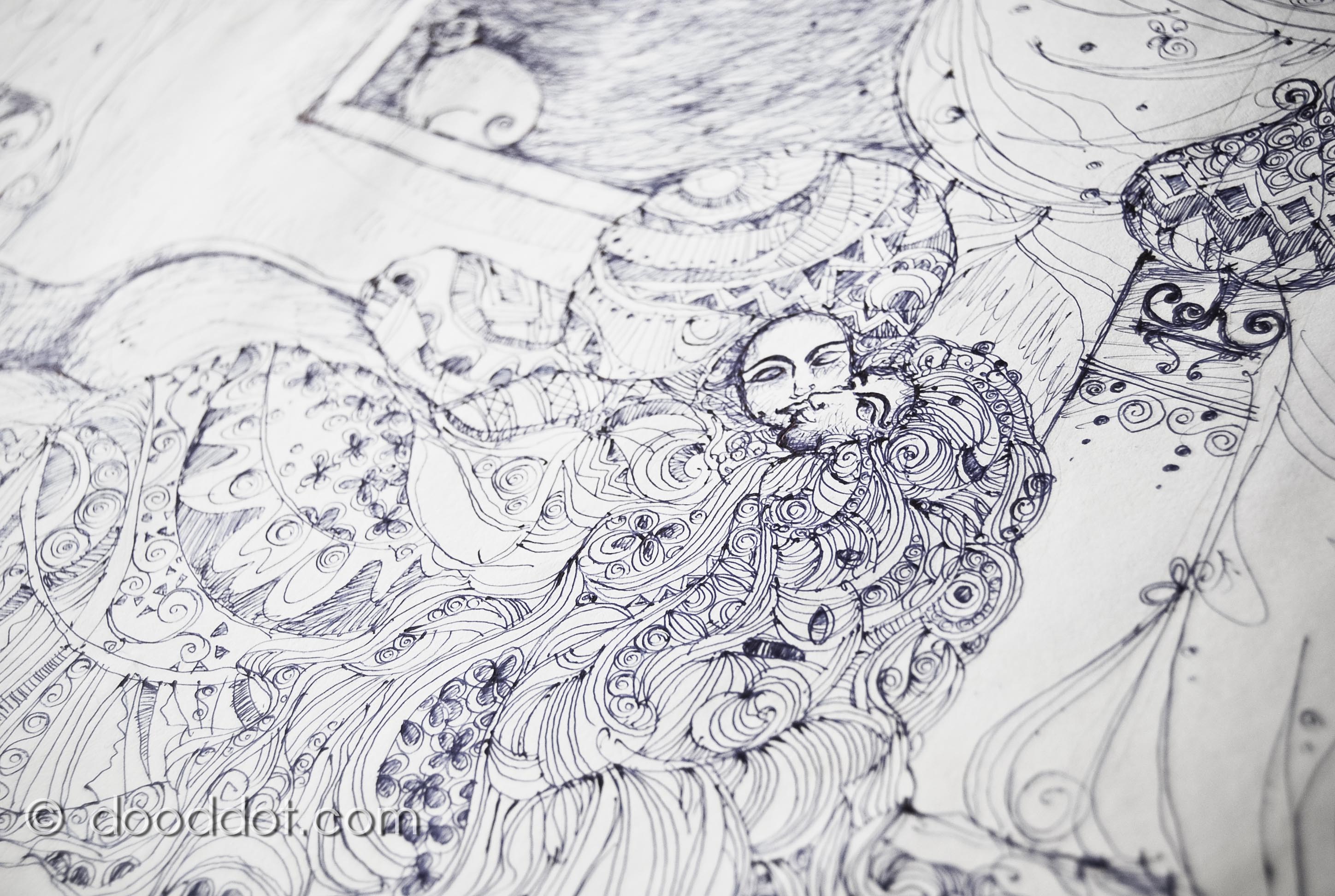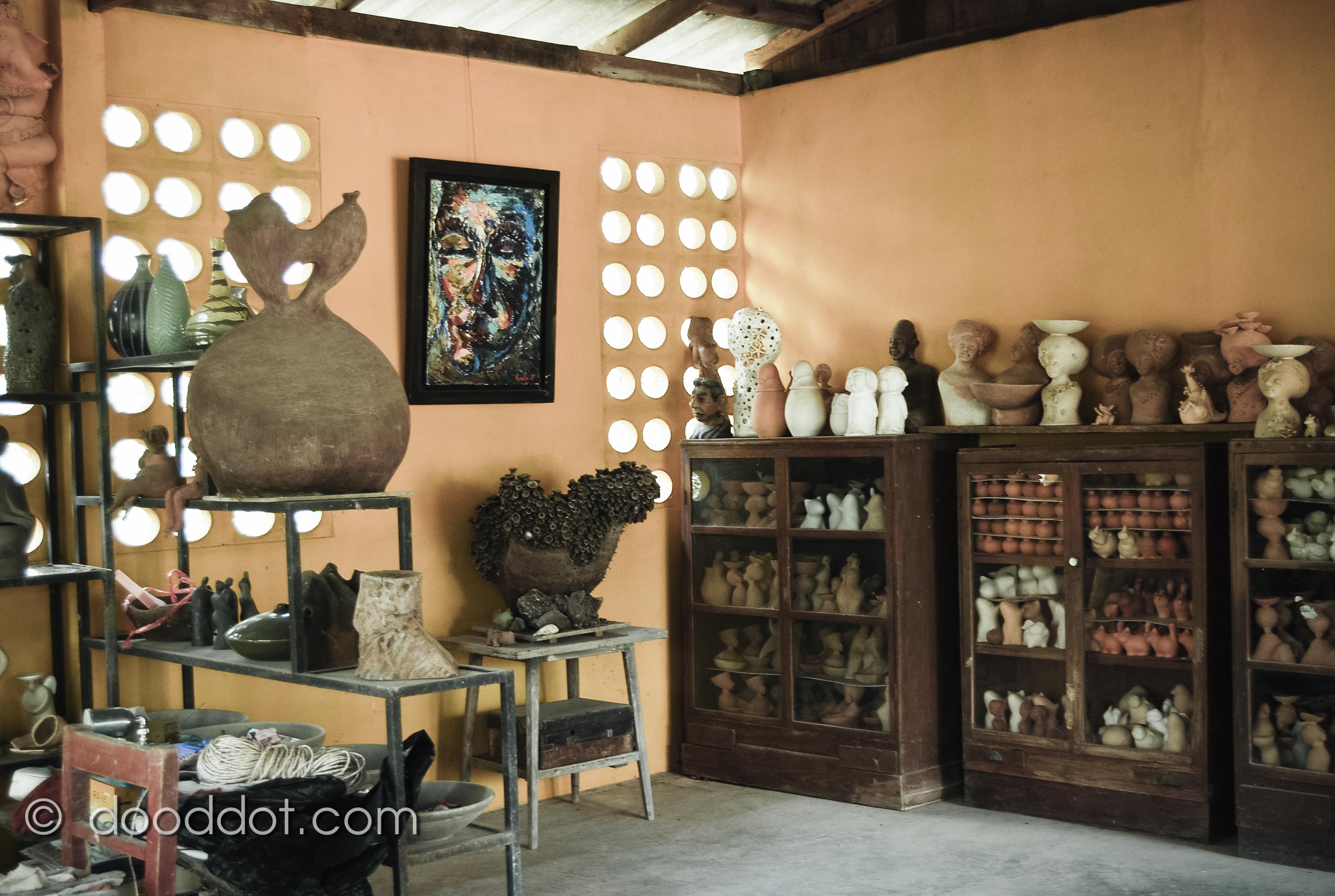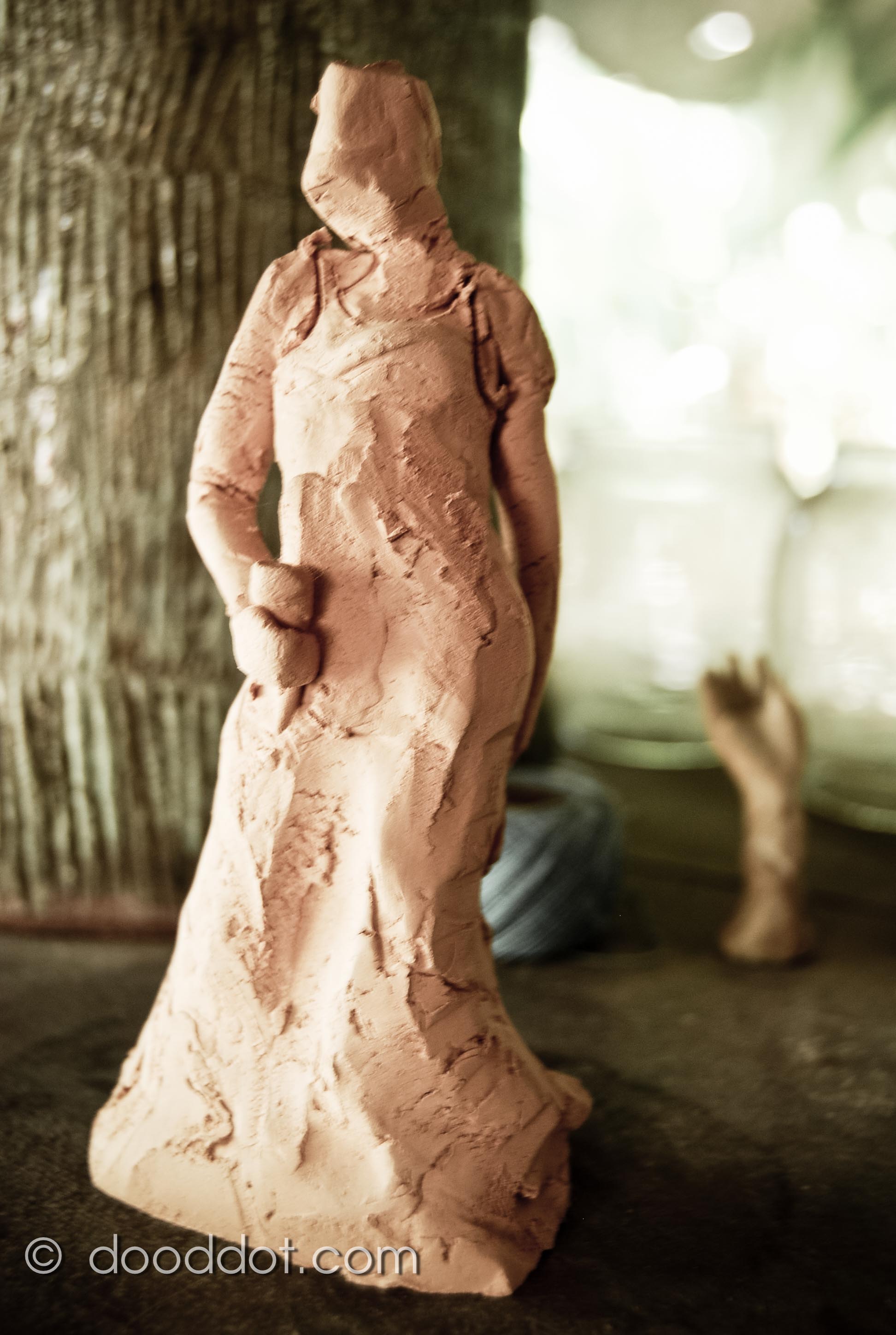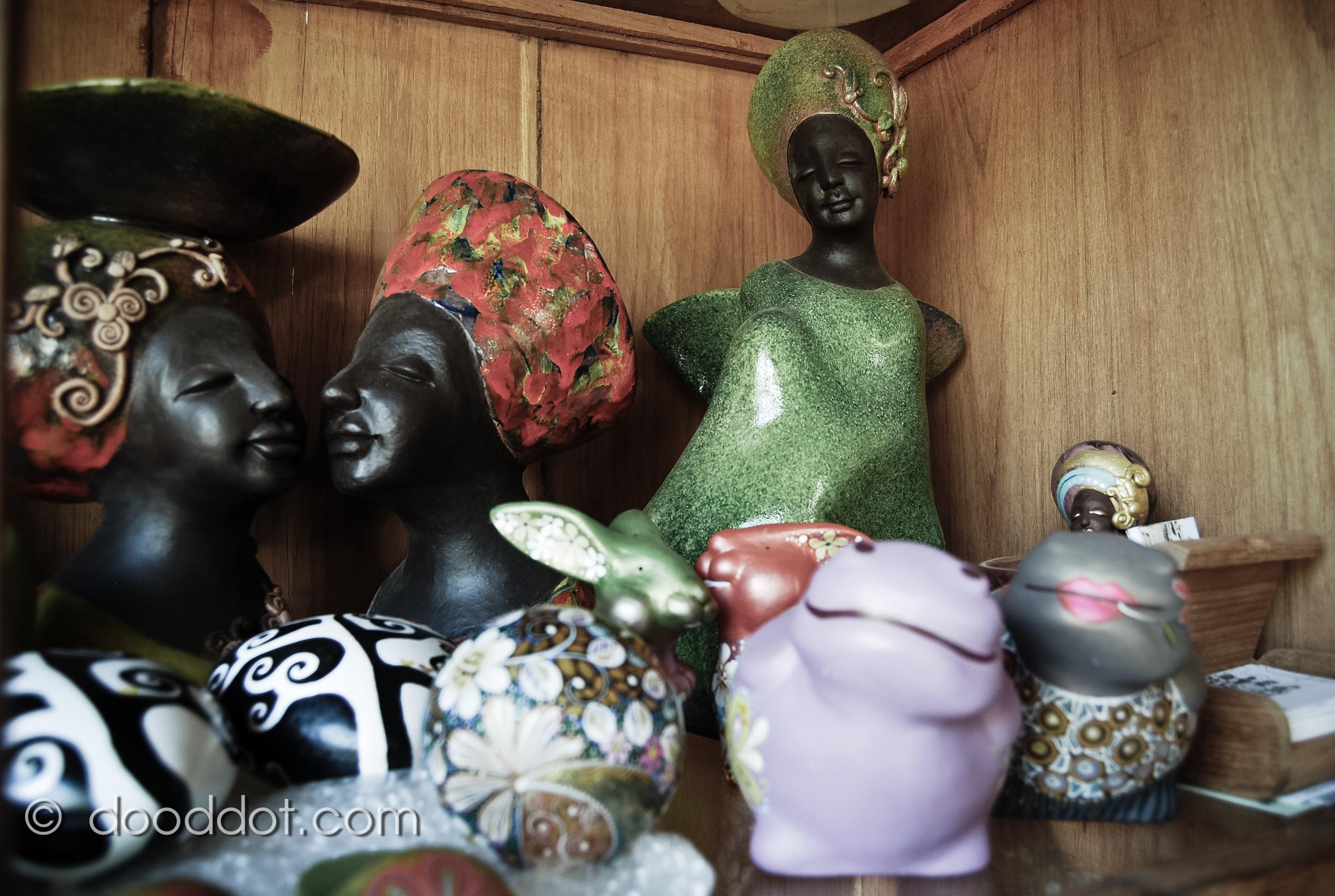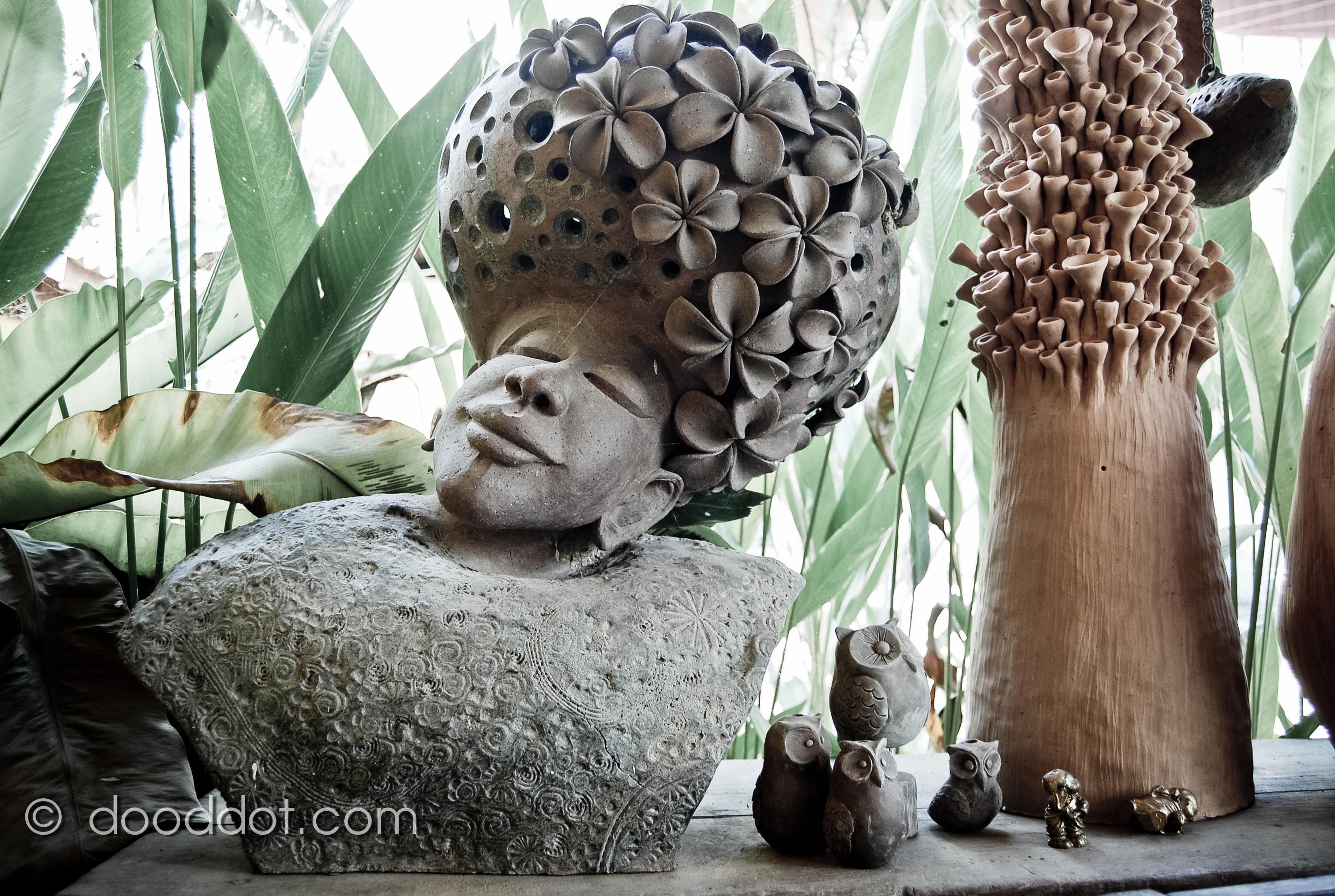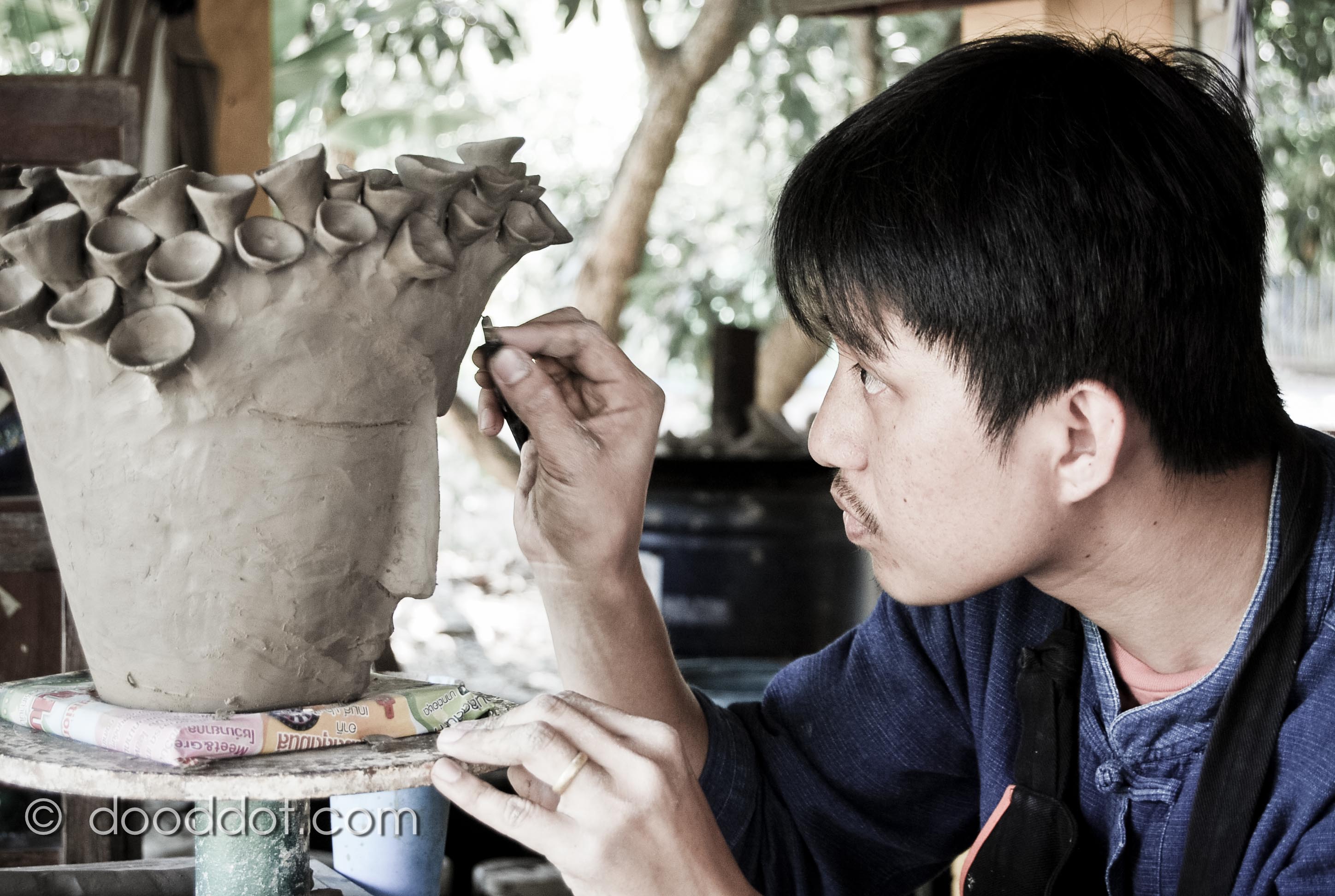
ไกลออกไปจากตัวเมืองเชียงใหม่ เราเดินทางไปที่บ้านหลังหนึ่งในเมืองแม่โจ้ พบกับสตูดิโอเล็กๆ บรรยากาศน่ารักๆ ที่เต็มไปด้วยรูปปั้น เครื่องปั้นดินเผาคนเรียงรายเต็มไปหมด “ลองสังเกตุดูว่างานที่นี่มักจะเป็นหุ่นหน้าคนที่มีแต่ความสุข และรอยยิ้ม” คำบอกเล่าจากศิลปินช่างปั้น ที่ต้อนรับเราด้วยรอยยิ้ม และพูดคุย อธิบายวิธีการทำงานอย่างง่ายๆ และเป็นกันเองให้เราได้ฟังกัน พี่ภู ภูริดล พิมสาน ศิลปินช่างปั้นชาวเหนือ Dooddot’s interview อาทิตย์นี้
We traveled faraway from Chiang Mai to a place in Mae-jo and found a cute little studio filled with human pottery sculptures. “You can only see happy faces here, just notice!” – told through the pottery sculpture artist Puridol Pimsarn who welcomed us with smiles and made us understand what his work is all about. Keeping up with a Northern sculpture artist with Dooddot all this week.
DD: พี่ภูเป็นใครมาจากไหนช่วยแนะนำให้เรารู้จักหน่อยค่ะ
ตอนเด็กเราก็เป็นแค่เด็กบ้านนอกคนหนึ่ง เรื่องของศิลปะก็ยังไม่เข้าถึงโรงเรียนในบ้านนอกซักเท่าไหร่ ครูศิลปะก็ไม่มีหรอก แต่ว่าเรารู้ว่าเราชอบวิชาที่อาจารย์เขาให้เราประดิษฐ์ พอมัธยมทางบ้านเขาส่งมาให้เรียนในเมือง แต่เราเป็นคนที่ทำได้ไม่ดีเท่าไหร่ แต่เราชอบกลับมาทำที่บ้าน ทำนอกเหนือจากที่อาจารย์สั่ง บางทีก็นั่งวาด drawing ของเรามาเรื่อยๆ แล้วเราก็มาเรียนปวช. เรียนสถาปัตย์ แล้วเหมือนชีวิตมันแบบจับพลัดจับผลูตลอดเวลา แต่พอเข้าเรียนปวส. เราก็มีโอกาสได้เข้าไปเรียนคณะภูมิสถาปัตย์ (landscape) เราก็เรียนมาเรื่อยๆ หลังจากนั้นมันก็รู้สึกว่ายังไม่ใช่ แล้วเราก็ไปเห็นเขาสอบศิลปกรรมพวกเครื่องปั้นดินเผากัน เราคิดว่ายังไงก็ติดแน่ เพราะเขารับทั้งหมด 15 คน แต่คนสมัคร แค่ 6 คนเอง อย่างน้อยเราก็ไม่ต้องกลับไปช่วยที่บ้านขายของ พอถึงคราวนี้เราก็เลยต้องจริงจังกับมันแล้วหละ แต่ว่าเราไม่มีความรุ้เรื่องเทคนิคแบบเซรามิกมาก่อนเลย
“
เราต้องทำงานออกมาเยอะๆ ต้องฝึกเยอะๆ
เราอยากรู้อะไรเราก็ต้องหา ต้องทำมัน
“
DD: Could you please introduce yourself to us?
I was living in the rural area during my childhood. There was no art teacher because art wasn’t quite there yet. I enjoyed the class where teacher let us do handmade stuff. My family sent me to continue my study in town during my middle school but I didn’t do it quite well. I just liked to come back home and do things differently than what teacher wanted us to do. I keep drawing stuff until now. I had Architecture in my Vocational Certificate and continued to Landscape Architecture in my Higher Vocational Certificate and it just didn’t feel right. There was a test for pottery sculpture class and I knew I would get in because there were only 6 people there out of the quota of 15. At least I don’t have to go back home and help my family sell stuff. I knew I had to be serious with this even I didn’t have any ceramic skills. Not knowing anything makes it become more challenging and pushed us to think and do differently from the others.
DD: ความต่างตรงนี้ทำให้เกิดอุปสรรคในการเรียนบ้างไหม
การที่เราไม่มีความรู้พื้นฐานด้านนี้มาก่อนทำให้เรากล้าที่จะทำ กล้าที่จะคิด ซึ่งต่างจากเพื่อนๆคนอื่น ที่เรียนมาด้านนี้โดยตรงน่ะ คือคนอื่นเขาเรียนมาก่อนเราแล้ว 5 ปี แล้วเขาชำนาญอุปกรณ์ทุกอย่าง แต่ถ้าเราไม่รู้อะไรเราก็ถามเพื่อนน่ะ เพื่อนก็ยินดีช่วยเรา สิ่งที่เราไม่รู้เนี่ยมันก็เลยเป็นแรงผลักดันให้เราต้องทำงานออกมาเยอะๆ ต้องฝึกเยอะๆ เราอยากรู้อะไรเราก็ต้องหา ต้องทำมัน แล้วเราก็เริ่มหาไสตล์ของตัวเองเจอและรู้ว่าเราถนัดแบบ hand built โดยที่ไม่ใช้เครื่องหมุนในการบังคับทรง เราก็เลย “เอาวะ” เอาไสตล์นี้ให้มันทะลุปรุโปร่งไปเลย
DD: Was this difference your obstacle while you were studying?
All my classmates had been studying 5 years before me and they knew all the skills and techniques really well. I just asked when I came to a dead end and they were just so welcomed to help me out. This encouraged me to create more work, practice harder and keep finding myself until I found out that my style would probably go with handmade skills and I’ve been sticking with this until now.
DD: พี่ภูเริ่มมาจริงจังที่คิดว่าสิ่งนี้จะกลายเป็นอาชีพเลยได้เมื่อไหร่
หลังจากเรียนจบ เราก็คิดว่าเราคงต้องเดินทางมาสายทางนี้แล้วหละ แล้วเราก็ทำงานมันเยอะๆ และก็ลองเอาไปขายดู แล้วผลตอบรับมันค่อนข้างดีพอสมควร มีคนมาซื้อเราเยอะ เราก็เริ่มมีกำลังใจ แบบเราก็ไปได้น่ะ ก็เลยจับงานด้านนี้มาตลอด รวมๆแล้วก็ 8 ปี ในวงการงานปั้นในเชียงใหม่
DD: So when were you so sure that you can make a career out of it?
I tried to sell my work after graduation and it went quite well. People supported me more than what I expected and here comes the courage. I’ve been working in this industry here for about 8 years now.
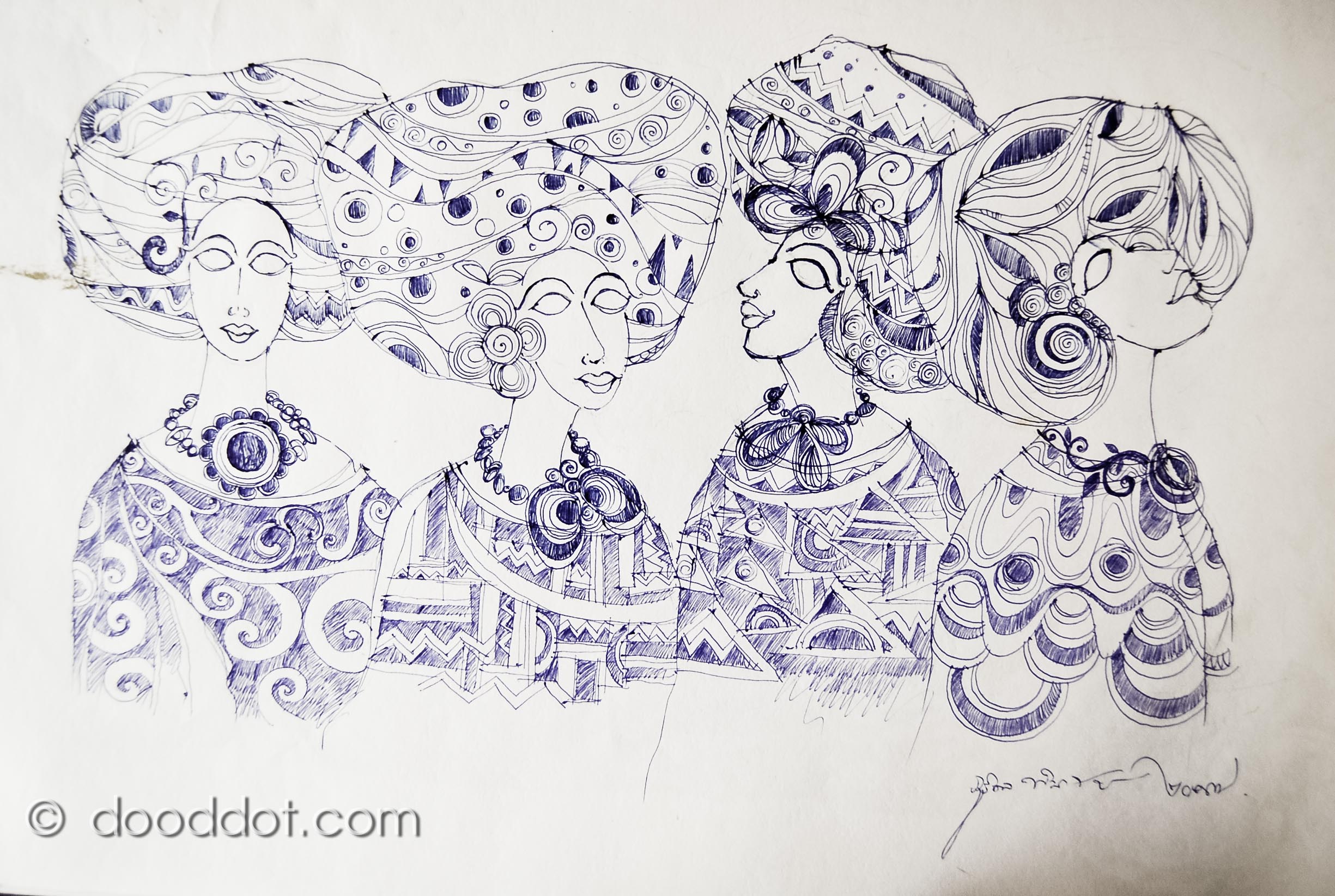
DD: ด้วยสไตล์งานของพี่ภูแบบนี้มันเริ่มมาได้ไงค่ะ
นี่เลย ตอนเรียนเราก็เห็นเพื่อนๆ ปั้นแจกันกันเราก็เลยปั้นบ้าง แล้วด้วยที่เราไม่มีความรู้ทางด้านนี้มากพอ ไม่รู้เรื่องเทคนิคต่างๆ พอดีฝนตก แล้วดินมันทรุดยุบตัว มันก็เลยออกมาเป็นแจกันเบี้ยว พอเรามองแล้วเราก็คิดว่ามันเหมือนคนนั่งคุกเข่าเราก็เลยปั้นหัว ปั้นหน้าใส่ลงไป เลยกลายเป็นว่าหลังจากนั้นเราปั้น figure มาโดยตลอดจนทุกวันนี้ เพราะด้วยความไม่รู้อะไรเลยของเรา ทำให้เป็นการจุดประกายให้เราได้งานใหม่ๆ และแตกต่าง เหมือนบางทีที่อาจารย์อยากให้เราปั้นแจกันซักหนึ่งชิ้น มันยากน่ะที่เราจะทำให้มันแตกต่าง คนนั้นก็เอาไปแล้ว คนนี้ก็ทำไปแล้ว มันยากเพราะมันต้องเค้า
DD: How did this style all start?
I saw a couple of friends making pottery vases and I followed without having enough skills and techniques. It was raining and caused the clay to subside so the vase turned out misshaped. I kept looking at it and felt as it was a man kneeled down so I added it a head and a face. Ever since I’ve been making figures all these times without knowing anything and it really sparkles new different ideas. I think it’s quite difficult to do a work differently when your professor wants everyone to make a vase and it’s likely that everyone has his own way of doing it.
DD: สตูดิโอนี้เริ่มมาได้ไงค่ะ
คือมีเพื่อนคนนึงยุให้เราทำ แต่เขาไม่ทำน่ะ เราทำคนเดียวเลย เริ่มมาจากสตูดิโอเล็กๆ ที่บ้านเช่าในเมือง ซื้อไม้ไผ่มาสามลำสี่ลำแล้วก็สร้างเป็นแค่เพิงหมาแหงนน่ะ เล็กๆเลย ด้วยวัยเด็กๆด้วยน่ะ ที่เราอยู่ในครอบครัวที่ค้าขาย อีกมุมนึงก็ทำเกษตรกรรมด้วยแบบทำอะไรด้วยมือเปล่าๆ แล้วสิ่งเหล่านี้มันคงอยู่ในตัวเรามา มันเลยทำให้เราคิดว่ามันต้องอยู่ได้กับสิ่งที่เราทำ เราก็เลยทำสตูขึ้นมาเลย อาจารย์จะสั่งไม่สั่ง เราก็ทำหมด แล้วถ้ามีอันไหนที่มันตรงกับที่อาจารย์สั่งเราก็เอาไปส่งเลย เพราะมีอาจารย์คนนึงสอนว่า “สมัยที่เราเรียนเนี่ย เป็นการทำงานที่ไม่มีต้นทุนเลยน่ะ” เพราะว่าเราจ่ายค่าเทอมไปแล้ว แบบเราทำงานมา 10 ชิ้น 20 ชิ้น เราสามารถเอาไปขายได้เลยน่ะ สร้างตัวได้เริ่มต้นจากตรงนี้ได้ ก็เลยทำให้เยอะๆ แล้วเอาไปขายได้
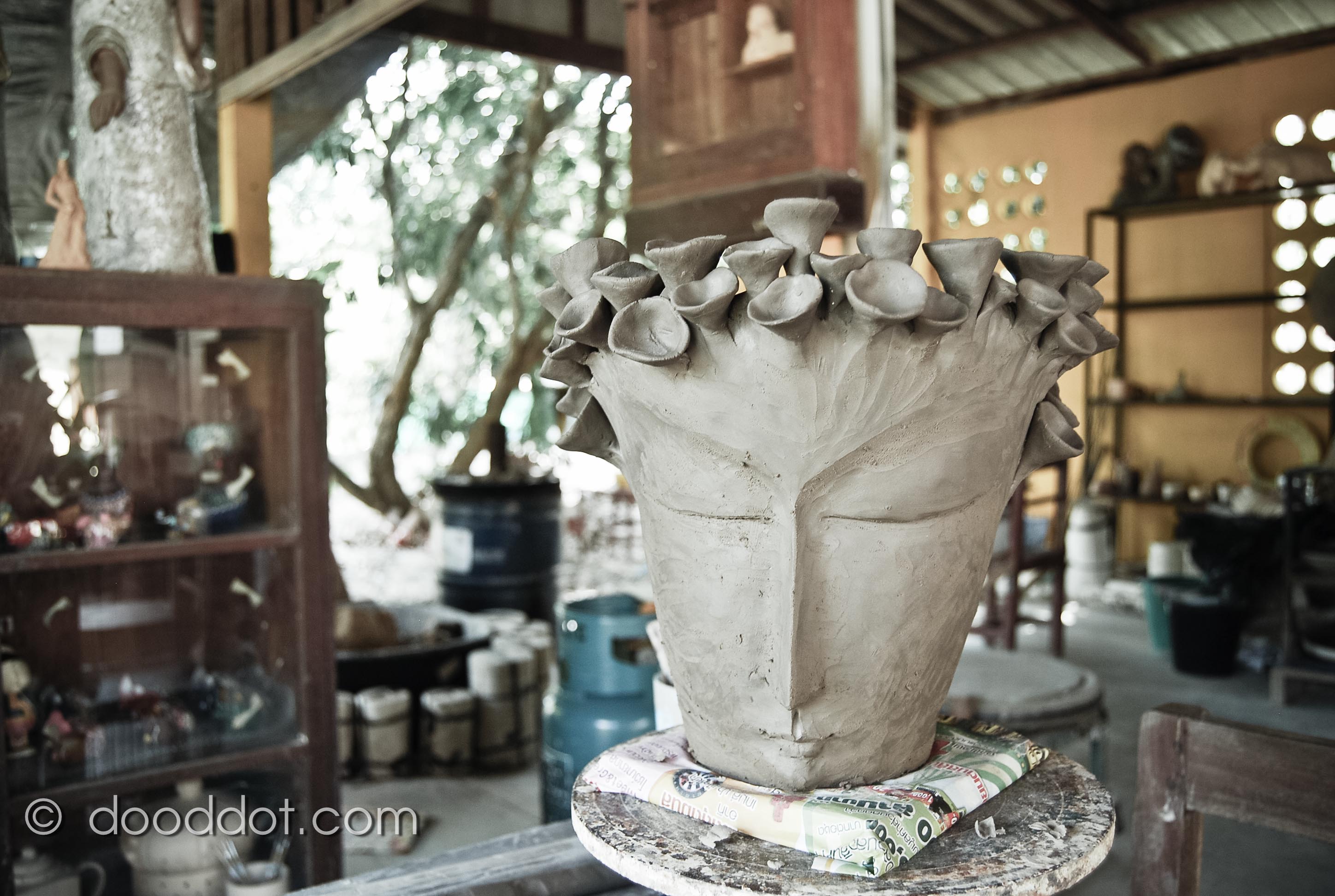
DD: How did this studio happen?
One of my friends pushed me to do it. It started with a small studio in a rented house in the city. I bought a couple of bamboo sticks to build a shed, just a small one. These handmade skills have been with me since little as we make a living from agricultural products. It just makes me realize that I can live with anything I made myself, that’s how this studio came up. My works were not bounded to only my professor’s tasks. I just made everything I wanted to and if it matched the task then that’s a plus. One professor taught me “There is no investment required while you are in school”. We paid the tuition and made 10-20 pieces of work so why don’t you start making a living out of them from now?
DD: สตูดิโอทำงานที่นี่มีกิจกรรมอะไรบ้างค่ะ
คือสตูดิโอนี้เราก็ปรับมาเรื่อยๆ แต่ที่นี่ก็สี่ปีครึ่งแล้ว แล้วก็เริ่มต่อเติมมาเรื่อยๆ แต่ยังไม่หมดที่คิดไว้น่ะ เราคิดไว้ว่าที่นี่จะเป็นเหมือนสถานที่ที่เพื่อนๆ พี่ๆ น้องๆในวงการศิลปะมาแจมกัน แลกเปลี่ยนกันที่นี่ เราก็คิดว่าข้างหน้านี่ก็จะทำเป็นโชว์รูม ที่โชว์งาน แต่เราต้องค่อยๆทำไป เราก็มีคอร์สเรียนน่ะ มันก็กลายเป็นวงการ มีวงสังคม มันก็เริ่มกว้างขึ้น บางคนเขาเรียนอยู่แล้วที่เมืองนอก เขามา workshop ที่บ้านเรา ครั้งหน้าเราอาจจะได้ไป workshop ที่บ้านเขาบ้าง แต่เรื่องคอร์สเรียนก็ไม่ได้เป็นตัวรายได้หลักน่ะ แต่มันได้ connection ได้เพื่อน ได้ประสบการณ์หลายๆอย่าง บางทีเราก็ได้ฝึกภาษาอังฤษไปในตัวด้วย
DD: What are the activities around here in the studio?
We’ve been adjusting a lot of things around here and we are about four and a half years old now. These are not yet completed of what I have in mind. My idea is to have this studio as a get together place for art people in the field. In the future we can make a showroom to have the work exhibited. This can be done only a little at a time because I still have courses to manage. This slowly becomes a society and is getting broader. People who study abroad come to our workshop sometimes as well. Next time maybe we can join their workshop there too! Courses here are not our main income. It only gives connections, new experiences and allows me to improve my English skills.
DD: อยากให้พี่ภูพูดถึงเรื่องเทคนิคและวิธีการทำหน่อยคะเผื่อใครสนใจ
ถ้าเรื่องของเซรามิคเริ่มต้นที่วัสดุหลักคือ ดิน ต้องมาจากแหล่งดินที่ท้องนาและก็เขานำไปบดละร่อนให้เรียบร้อย ก้จะได้ดินผงแล้วเอาไปผสมน้ำก็จะได้ดินก้อน หลังจากนั้นเราก็เอามาขึ้นรูป หลังจากที่ได้อย่างงี้ เราก็ต้องรอให้มันแห้งประมาณ 5 วัน ห้ามใช้พัดลมน่ะ แล้วเราก็นำไปเผาบิสกิตด้วยอุณภูมิ 750 องศา สีส้มๆนวลๆ พอเราปุ๊บเราก็ต้องเอาไปเคลือบด้วยส่วนผสมที่ซับซ้อนนิดนึงคือ ดิน หิน ขี้เถ้า ผสมกับสารให้สีที่มีหลายๆตัวเลย แล้วเราก็ชุบหรือทาหรือพ่นมัน ถ้าอยากได้สีสดๆก็จะต้องเคลือบด้วยอุณหภูมิที่ 900 – 1100 องศา แต่ถ้าเคลือบอีกแบบจะอยู่ที่ 1250 ด้วยบรรยากาศมีสองแบบคือการสันดับสมบูรณืและการสันดับไม่สมบูรณ์ แต่ง่ายๆคือสองอย่างนี้จะได้ผลลัพธ์ที่ต่างกัน มันเหมือนเป็นการทดลองน่ะ เราไม่รู้ว่าออกมาแล้วจะเป็นสีอะไรต้องเดาเอา
DD: Could you please tell us more about techniques? In case there are people who have interests in this field.
If you talk about ceramics, clay is the heart of everything. It comes from the paddy field and they winnow it to get smaller particles of soil. We blend it with water to get clod of soil and build a structure out of it. After this we will need to wait for another 5 days to dry it up (don’t use a fan by the way!) and here comes the biscuit firing process at 750 degrees. It gets a little more complicating after the soil turns to sort of orange. We need to coat it with soil, rock, ash, chemical products and we spray or dip in it. If you want bright and colorful colors then you will have to go for 900-1100 degrees. If you do it another way then the temperature will be at 1250 degrees with two different atmospheres; completed and incompleted one. These two methods give different results. It is an experiment. I don’t know how the color would turn out. We only need to guess.
DD: ถ้าเราไม่ไปเอาเคลือบเราจะเอาไปทำไรได้บ้างค่ะ
เราก็เอาไปเพ้นท์ได้ หรืออย่าง Biscuit สีแดงที่เราเคยเห็นกันไป เขาจะเรียกว่า terra-cotta แต่ของพี่ที่แตกต่างเพราะว่า บางทีมันเสียหายแบบมีรอยร้าว แล้วมันเหมือนงานไม่เสร็จ แล้วพี่ก็จะเอามาเพนท์เอามาเคลือบมันและมันก็จะได้อีกแนวนึงอีก feel นึงออกมา
DD: What else can we do if we don’t coat it?
We can paint. Look at the red biscuit we’ve seen, they call it as Terra-Cotta. Mine is a little different because there are some cracks as if these are not quite done yet. This will give a different feeling after I paint and coat it.
DD : พี่ภูมักจะได้แรงบันดาลใจมาจากไหนค่ะ
โดยส่วนตัวแล้วแรงบันดาลใจของการทำงาน เกิดจากการดำเนินชีวิตในทุกวัน การได้พบเห็นอิริยาบทของผู้คนแล้วเกิดความประทับใจ ก็ดี หรือ การได้พบเห็นความงามที่ถูกสร้างสรรค์จากธรรมชาติ หรือบางครั้งก็เอาความประทับใจทั้งสองด้านมาผูกเรื่อง สร้างเรื่อง ให้คนได้คิดตาม คล้อยตาม และสร้างความสุข ความสงบ และรอยยิ้ม บางครั้งเดินอยุ่ข้างทางเห็นคนจุดกองไฟ เราก็เก็บรายละเอียดตรงนั้นมาปั้น
“ณ ขณะที่ผมทำงานอย่างมีความสุข ผมหวังให้ ผู้ที่ได้พบเห็น ได้สัมผัส มีความสุขกับผลงานศิลปะที่ผมทำขึ้น”
DD: Where do you get all these inspirations?
Personally i got the inspiration from everyday life when i saw all the people behave or acting, i’m impress from that. Or I met the beautiful thing that created from the evironment around us absolutly its natural. I always brought both thing then created my story and developed then happy / peace and smile with it. Sometimes I see people lighting up the fire and then I come home to create lined sticks, pile them up with some flowers, leaves and place the fire under it. This is more fun, much better than committing yourself to a certain task. That’s too much pressure.
“While I’m happy with my artwork I hope people who see who touch and happy with my artwork that I’ve created.
บางทีสิ่งที่เราต้องทำเพื่อความอยู่รอดมักจะเป็นสิ่งที่เราไม่ชอบ แต่สิ่งที่เราชอบและอยากทำมักจะยากที่จะเริ่มและได้ผลตอบแทนใดๆกลับมา แต่ชายคนนี้สามารถนำสิ่งที่ตัวเองรักและความอยู่รอดของชีวิตดำเนินไปพร้อมๆกันอย่างมีความสุข หากว่าเรามีสิ่งที่เราคิดว่าเราทำแล้วมีความสุขลองทำมัน ศึกษามันให้สุด หรือบางครั้งสิ่งที่ตัวเองค้นหามานานมันอาจจะหาเจอโดยที่เราไม่ได้คาดคิดไว้ก็เป็นได้ ©
Sometimes what we need to make a living is not what we prefer. It is difficult to start with what we like and expect something in return. This man is able to do what he loves and makes a living out of it happily. If there is a certain thing you think you will be happy with it, just go for it. It is possible that what you have been looking for all your life is not what you have expected. ©
RECOMMENDED CONTENT
อาดิดาส เปิดตัวชุดแข่งขันทีมชาติอิตาลีคอลเลกชันแรก ร่วมกับสหพันธ์ฟุตบอลอิตาลี หลังประกาศความร่วมมือกันอย่างเป็นทางการตั้งแต่วันที่ 1 มกราคมที่ผ่านมา โดยทีมชาติอิตาลีทุกระดับจะสวมชุดแข่งขันของอาดิดาส ไม่ว่าจะเป็น ทีมฟุตบอลชาย ทีมฟุตบอลหญิง ทีมฟุตบอลชุดเยาวชน ทีมฟุตซอล ทีมฟุตบอลชายหาด รวมถึง ทีมอีสปอร์ต (e-sports)









